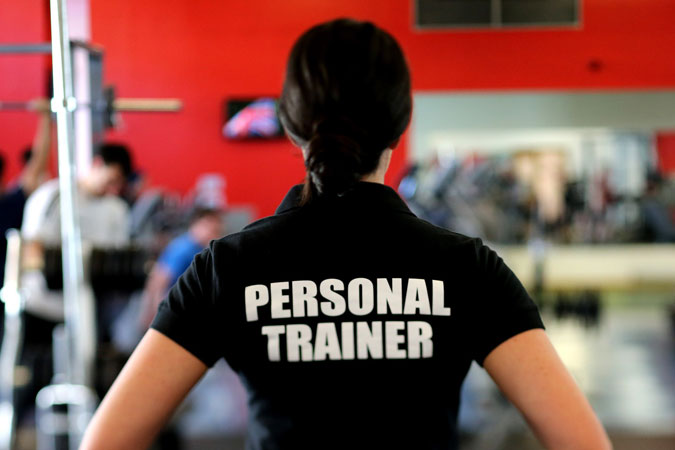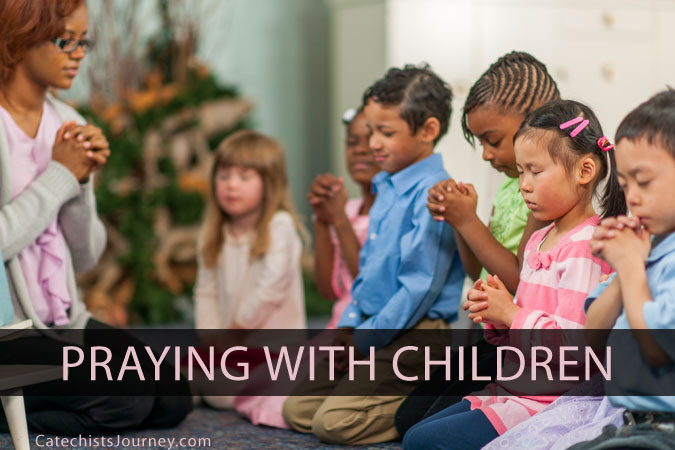
“Central aspects of the formation of children are training in prayer and introduction to Sacred Scripture” (General Directory for Catechesis 178). Today let’s focus on the training in prayer part of that. Training indeed is key, but how do we understand that?
Think of a personal trainer: when we need to get in shape or need new motivation to stay in shape, we might hire a trainer to teach us the basics of fitness and how to use exercise equipment, provide encouragement, show us what to do to get to the next level, adapt suggestions to our situation, and push us further than we might go on our own. So let’s apply that to catechesis. Children need trainers, or mentors, in prayer.
Teach the Basics
No matter what age level we work with, there are certain prayer basics we should teach the children. A good curriculum and parish catechetical leader will help you know which traditional prayers should be taught at each age, but reminders of prayers like the Lord’s Prayer and the Hail Mary are important. Beyond the traditional, often-memorized prayers of the Catholic faith, liturgical prayers can be introduced so children understand better what’s happening at Mass. And teaching prayer forms like the Ignatian Examen or lectio divina give young people ways to go deeper in a relationship with God and make prayers their own.
Encourage
When we mentor children in a life of prayer, we offer encouragement. Help them place prayers in context, and invite them to try a new prayer style. Use phrases like, “You might recognize the words of today’s prayer from [earlier in the lesson, a Scripture reading, etc.].” “Let’s try our silence challenge for a bit longer than last week.” “Good job with your first experience of guided reflection.” “You’ve heard this at church, so let’s take a closer look at the words.” “Thank you for your willingness to try this different way of praying.”
Go to the Next Level
Beyond introducing traditional prayers, we want children to take them to heart. The Catechism of the Catholic Church teaches us that, “The memorization of basic prayers offers an essential support to the life of prayer, but it is important to help learners savor their meaning” (#2688). Discuss the meaning of the words of the prayers, and do activities to help the children understand the prayers more clearly. For example, in my groups, I point out that the words of the Hail Mary came from Scripture when we are studying the Annunciation and the Visitation, giving the words context. Fellow Catechist’s Journey contributor Barb Gilman explains how she helps her third graders take to heart the Apostles’ Creed in this article.
Adapt to the Situation
If something isn’t resonating, it doesn’t mean it never will, but maybe today is not the right day for a certain type of prayer. For instance, maybe a school situation affected many of the students so they are looking for something more formal on a given day, or they need to work through feelings with a more open-ended approach during a different session. Catechists, with practice, can change things on the fly when necessary to adapt to the needs of the young people sitting in front of them at a given moment. Remember, too, that sometimes the young people’s maturity level will make a difference in why some prayers might resonate with some groups and not with others. While I firmly believe in sharing different types of prayer with young people, as I get to know my group, I will have an idea of which prayer forms might appeal most at a particular time and place.
Push Us Further
While it’s often tempting to stay with prayers that children have mastered, we cannot stay at a plateau in prayer that doesn’t allow for deepening friendship with God. Just as with exercise the same number of push-ups would not have the same effect in month one of a workout regimen as in year two, we need to push further to grow. We wouldn’t expect a first grader to maintain prayerful silence for a 12-minute guided reflection, but gradually increasing prayer times through the years will make older students ready for that longer period of prayer. Challenge students to try different methods of prayer to see what effect they may have. Maybe after a few months focusing on traditional memorized prayers, the students will be ready to practice lectio divina. After trying guided reflection, an extended period of silence for conversation with the Lord might lead the young people to a different appreciation of prayer time. After trying a 30-second silence challenge for a few weeks, gradually increase the silent time to two or three minutes (or whatever is practical for the age group and time allotted for class).
Catechists can be effective mentors in prayer for children by being committed to their own prayer lives and being open to letting the Holy Spirit work in the children. We need to think of ourselves as personal trainers in prayer and participate in prayer experiences with our students, as models.
Have you thought of yourself as a mentor in prayer for your students? How can you take one of these ideas of the personal trainer in prayer to become a more effective catechist?
See the Prayers and Practices of Our Faith section of Finding God for prayers appropriate at each grade level and information on building a life of prayer.





Leave a Reply